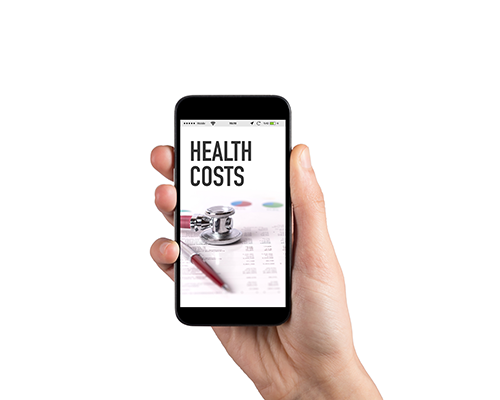Knowing where to go when an illness or injury occurs is a major factor when it comes to effective use of your health coverage. While the emergency room may seem like the easiest option when facing unexpected medical conditions, there are a few drawbacks. At the ER, “true emergencies” are usually treated first, which could mean long waiting times for other cases (sometimes lasting hours). Visiting the ER could also cost you more out-of-pocket.
Remember, you can use Castlight to compare costs for healthcare services, see personalized cost estimates and more. Castlight is completely confidential and provided at no cost to GW employees and their spouses/domestic partners and adult dependents covered under a university health plan.
Good news is there are several other options to consider when you need medical care.
Nurseline
Cost per visit: $0*
Availability: 24/7
For immediate, physician-approved answers to your health care questions.
With UHC’s Nurseline, free, confidential help is just a phone call or click away. Nurseline (available 24/7) allows you to speak with experienced nurses who can provide you with immediate and physician-approved answers to your health questions. Learn more about Nurseline, including when to use it, here.
Telemedicine: UHC Virtual Visit
Cost per visit: $10 copay (GW PPO) or 20% coinsurance after deductible (GW HSP)*
Availability: 24/7 (varies by provider)
For convenient, online access to a physician for minor health concerns.
When you’re feeling under the weather, the last thing you want to do is leave the comfort of your home to sit in a waiting room. Luckily, as a UHC medical plan participant, you have the ability to access a large network of care providers offering Virtual Visits. This aptly-named tool allows you to virtually consult with a doctor using real-time video technology – accessible through www.myuhc.com or through the Health4Me app (available on the App Store and on Google Play). Not only can you obtain a diagnosis during a Virtual Visit, but your doctor can also write prescriptions (if needed). Virtual Visits are ideal for allergies, sinus and bladder infections, bronchitis and other minor medical conditions. Appointments are not needed, and most visits take about 10-15 minutes.
Primary Care Provider (PCP)
Cost per visit: $30 copay (GW PPO) or 20% coinsurance after deductible (GW HSP)*
Availability: 40 – 50 hours per week
For non-urgent medical concerns with your regular doctor.
If your condition is not urgent – or if you need routine, primary/preventive care treatment – it’s often best to visit your primary care doctor. Your doctor already knows you and your health history, has access to your medical records and can provide follow-up care and specialist referrals. You may also pay the least amount out-of-pocket when you receive care in your doctor’s office.
Convenience Care Clinic
Cost per visit: $30-$50 copay (GW PPO) or 20% coinsurance after deductible (GW HSP)*
Availability: 60 – 80 hours per week
For non-urgent care when you cannot make it to your doctor’s office.
In cases where your condition is not urgent but you cannot make it to your doctor’s office, you may want to consider visiting a convenience care clinic. These clinics are often located in malls or retail stores (such as CVS/pharmacy, Walgreens, Walmart and Target), and offer services without the need to schedule an appointment.
Services at a convenient care clinic may be provided at a lower out-of-pocket cost than at an urgent care clinic, and are subject to PCP office visit copays or deductible/coinsurance depending on your plan. Clinic services are generally available to patients 18 months of age or older, and may vary by clinic.
Typical conditions that may be treated at a convenience care clinic include:
- Common infections
- Minor skin conditions
- Flu shots
- Pregnancy tests
To find an in-network convenience care clinic near you, visit www.myuhc.com.
Urgent Care Center
Cost per visit: $30 copay (GW PPO) or 20% coinsurance after deductible (GW HSP)*
Availability: 60 – 80 hours per week
For injuries or illnesses that are non-life-threatening but that require immediate care when your doctor is not available.
What is an urgent care center, and when should I use one? The short answer is: when you need care fast (within 24 hours) outside of your doctor’s regular office hours, and when a convenience care clinic isn’t an option. Urgent care centers often have shorter waiting times and cost less out-of-pocket than the emergency room.
Examples of typical conditions that may be treated at an urgent care center include:
- Sprains
- Small cuts
- Strains
- Sore throats
- Mild asthma attacks
- Rashes
- Minor infections
Services available vary by center. If you choose to use an urgent care center, make sure it is in-network by calling the number on the back of your UHC ID card or by visiting www.myuhc.com.
Emergency Room
Cost per visit: 20% coinsurance after deductible (GW PPO and GW HSP)*
Availability: 24/7
For immediate treatment of critical or life-threatening conditions.
Sometimes, you have to visit the emergency room. Emergency services are always considered at the in-network benefit level. It is truly in your best benefit in terms of out-of-pocket costs to save the emergency room for emergencies; for conditions that are not emergent, utilize a convenience care clinic or urgent care center.
Examples of emergent conditions – for which you should go to the nearest emergency room or call 911 – include:
- Heavy bleeding
- Large open wounds
- Sudden change in vision
- Chest pain
- Sudden weakness
- Trouble walking
- Major burns
- Spinal injuries
- Severe head injuries
- Difficulty breathing
*Per visit treatment costs listed reflect costs at the in-network level; out-of-network costs may be higher. Please note that costs for specific guidance and care may vary from those represented here. Emergency room per visit cost estimates include facility charge and initial physician consultation.

